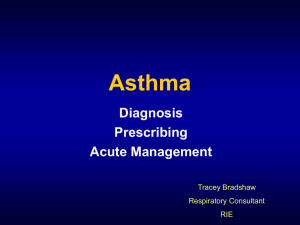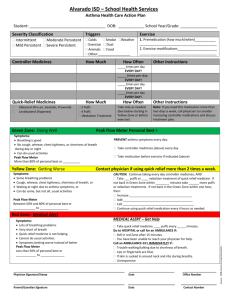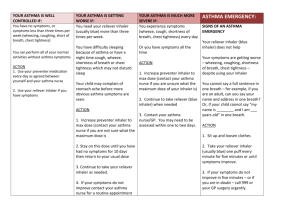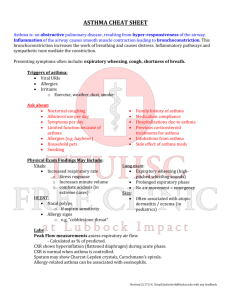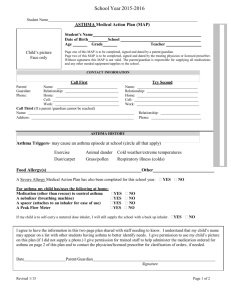Can they use it?
advertisement
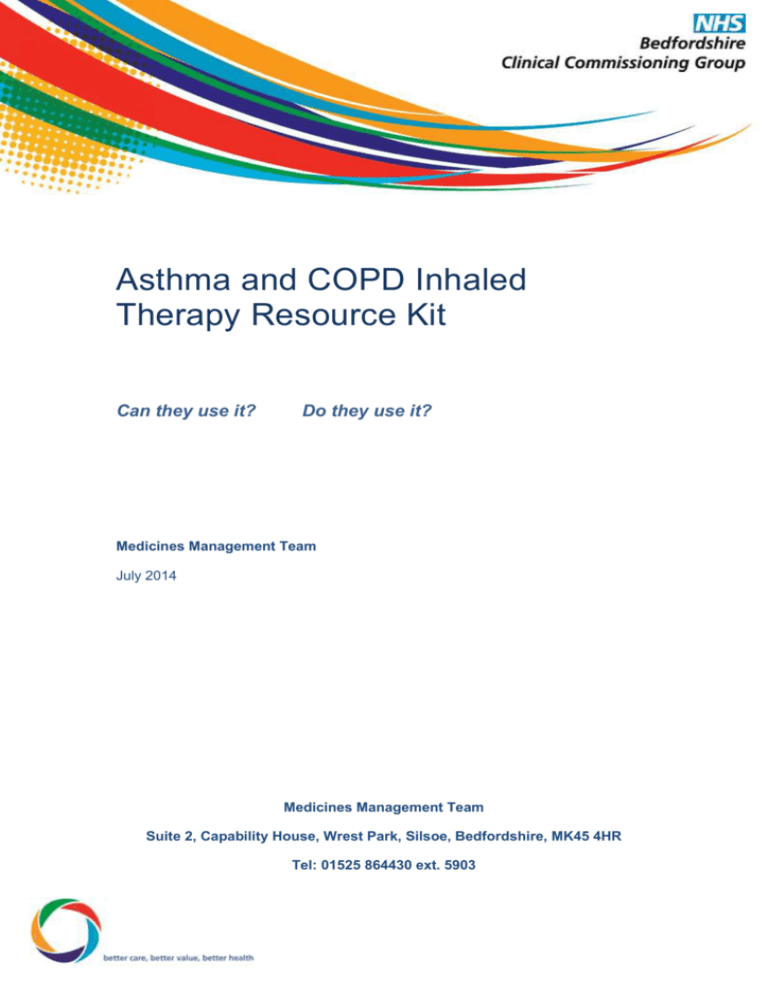
Asthma and COPD Inhaled Therapy Resource Kit Can they use it? Do they use it? Medicines Management Team July 2014 Medicines Management Team Suite 2, Capability House, Wrest Park, Silsoe, Bedfordshire, MK45 4HR Tel: 01525 864430 ext. 5903 Asthma and COPD Inhaled Therapy Resource Kit- Contents Introduction and acknowledgements BCCG Medicines Formulary – Updated monthly, check website for most recent edition. Bedfordshire and Luton Joint Prescribing Committee (JPC) Bulletins How to use your inhaler leaflets Information on expected number of inhalers used annually at stated doses ASTHMA Quick reference guide for the management of chronic asthma in adults Asthma Control Test and checklist Check list for asthma review Audit Project: Audit and Review of Adults with Asthma on High Dose Inhaled Corticosteroids Why asthma still kills- the national Review of Asthma Deaths (NRAD) May 2014 - Executive Summary Breathing Well Patient information pack COPD BCCG COPD guidelines Checklist for COPD review BCCG COPD 2013 audit action points Audit Project: Review the need for ICS/LABA inhaler in COPD patients with an FEV1≥50 DEVICES In-Check Dial Peak flow meter Placebo inhaler devices Introduction and acknowledgements This asthma and COPD resource kit has been put together by the Bedfordshire Clinical Commissioning Group (BCCG) Medicines Management Team (MMT) to support you in your work with patients assisting them to optimise the use of their inhalers for their asthma or COPD. This resource kit aims to supplement information contained in national guidelines such as the BTS/SIGN British Guideline on the Management of Asthma and the local COPD Guidelines. Many thanks to Luton CCG for sharing their asthma resource pack with us, some of which has been reproduced within this resource kit. We would also like to thank Chiesi Ltd. for donating the Breathing Well patient packs and demonstration inhaler, AstraZeneca, Boehringer Ingelheim, GSK and Teva UK for providing placebo inhaler devices. We hope you find this resource kit useful in your healthcare setting. We welcome any comments you may have, please contact the editor, Karen Homan, Commissioning Pharmacist, BCCG MMT, Suite 2, Capability House, Wrest Park, Silsoe, Bedfordshire, MK454HR. email: Karen.homan@bedfordshireccg.nhs.uk . These materials are based on the best available evidence but their application can always be modified by professional judgement. BCCG Medicines Formulary - Inhalers 3: RESPIRATORY SYSTEM 3.1.1.1 Selective beta2 agonists 3.1.2 Antimuscarinic bronchodilators 3.1.3 Theophylline BNF Section 3.2 Corticosteroids Compound preparations Short acting Salbutamol 100micrograms/dose inhaler CFC free Longer acting Easyhaler formoterol 12microgram/dose Ipratropium bromide 20micrograms/dose inhaler CFC free Tiotropium bromide 18microgram inhalation powder, hard capsule Phyllocontin Continus ® tablets 225mg Preparations Comments Clenil modulite® cfc-free aerosol inhaler 50, 100, 200 & 250 micrograms per dose Asthma Fostair ® cfc free inhaler 100microgram/6microgram Adult over 18 years NB extra fine particles and has 5 months shelf life when dispensed (100microgram extra-fine beclometasone dipropionate is equivalent to 250microgram CFCfree beclometasone dipropionate) Symbicort ® 100/6 turbohaler Child 6-12 years Symbicort ® 200/6 turbohaler Child 12-17 years COPD Fostair ® cfc free inhaler 100microgram/6microgram Symbicort ® 400/12 turbohaler The latest version of the formulary is available at: http://www.gpref.bedfordshire.nhs.uk/referrals/bccg-primary-careformulary.aspx (user registration required.) Appendix 1: Comparison of the ICS/LABA combination products Trade name Flutiform® Fostair® Device Pressurised metered dose inhaler (MDI) Pressurised MDI Strengths available Fluticasone/formoterol 50 / 5 microgram 125 / 5 microgram 250 / 10 microgram Beclometasone/formoterol 100 / 6 microgram Seretide® Symbicort® Accuhaler (dry powder, breath actuated inhaler) Evohaler (Pressurised MDI) Fluticasone/salmeterol Accuhaler 100 / 50 microgram 250 / 50 microgram Turbohaler (dry powder, breath actuated inhaler) Budesonide/formoterol 100 / 6 microgram 200 / 6 microgram 400 / 12 microgram 500 / 50 microgram Adult asthma prophylaxis / maintenance dose Adult asthma single maintenance and reliever therapy (SMART) 2 puffs BD with all strengths Not licensed 1-2 puffs BD (maximum 4 puffs daily) 1 puff BD for maintenance. Patients should take 1 additional puff PRN in response to symptoms and an additional puff if symptoms persist after a few minutes. Maximum daily dose is 8 puffs/day. Fluticasone/salmeterol Evohaler 50 / 25 microgram 125 / 25 microgram 250 / 25 microgram 100/50: 1 puff BD, reduce to 1 puff OD if controlled 250/50 and 500/50: 1 puff BD 50/25: 2 puffs BD, reduce to 2 puffs OD if controlled 125/25 and 250/25: 2 puffs BD Not licensed 100/6 and 200/6: 1-2 puffs BD (maximum 4 puffs BD, reduce to 1 puff OD if controlled) 400/12: 1 puff BD (maximum 2 puffs BD, reduce to 1 puff OD if controlled) 100/6: 2 puffs daily in 1-2 divided doses, for relief of symptoms use 1 puff PRN up to max 6 puffs, maximum 8 puffs/day (up to 12 puffs daily can be used for a limited time) 200/6: 2 puffs daily in 1-2 divided doses, up to 2 puffs BD; for relief of symptoms use 1 puff PRN up to max 6 puffs, maximum 8 puffs/day (up to 12 puffs daily can be used for a limited time) Child asthma prophylaxis / maintenance dose 2 puffs BD with 50/5 and 125/5 inhalers only in patients aged 12 yrs and over Not licensed COPD dose Not licensed Not licensed Price per unit ~30 days supply (see appendix 1 for price per dose) 120 actuations inhaler 50/5: £18 125/5: £29.26 250/10: £45.56 120 actuations inhaler 100/6: £29.32 Miscellaneous information Compatible with generic spacers: A2A Spacer, Able Spacer, Optichamber Diamond, Pocket Chamber, Vortex Fridge storage required The 100mcg dose of beclometasone in Fostair® is not bioequivalent to a 100mcg dose of beclometasone in other inhalers. Compatible with Aerochamber Plus spacer (and generic spacers) 100/50: 1 puff BD, reduce to 1 puff OD if controlled in children aged 4 yrs and over 250/50 and 500/50: 1 puff BD in children over 12 yrs old 50/25: 2 puffs BD, reduce to 2 puffs OD if controlled in children aged 4 yrs and over 125/25 and 250/25: 2 puffs BD in children over 12 yrs old 500/50: 1 puff BD 60 actuations Accuhaler 100/50: £18 250/50: £35 500/50: £40.92 120 actuations Evohaler 50/25: £18 125/25: £35 250/25: £59.48 Accuhaler preloaded, primed by opening. Easy to use, requires minimal manual dexterity to prime. Red warning seen with last 5 doses. Humidity protected. Evohaler compatible with Volumatic and Aerochamber Plus spacers (and generic spacers) 100/6: 1-2 puffs BD, reduce to 1 puff OD if controlled in children aged 6-17 yrs 200/6 and 400/12: 1-2 puffs BD, reduce to 1 puff OD if controlled in children 12-17 yrs 200/6: 2 puffs BD 400/12: 1 puff BD 120 actuations Turbohaler 100/6: £33 200/6: £38 60 actuations Turbohaler 400/12: £38 Turbohaler preloaded, primed by twisting. Easy to use, requires minimal dexterity. Cog wheel dose indicator with last 20 doses marked in red. Separate cap. Humidity protected. References/ Sources of Review 1. Bedfordshire and Luton Joint Prescribing Committee, Bulletin 137 Fostair® (beclometasone dipropionate (BDP)100mcg and formoterol fumarate dihydrate 6mcg metered dose inhaler) for asthma 2. British National Formulary No 65. London: British Medical Association and The Royal Pharmaceutical Society of Great Britain; March- September 2013. 3. Smith,K, Suffolk PCT Drug and Therapeutics committee ICS/LABA review, October 2012 4. British Guideline on the management of asthma. Produced jointly by SIGN and the British Thoracic Society (BTS) since 2003, sections of the guideline are updated annually. Guideline 101. May 2008, Revised May 2011, Section 4.3.4 revised Sept 2011, Section 1 revised Jan 2012. http://www.sign.ac.uk/pdf/sign101.pdf 5. NICE TA 138. Corticosteroids for the treatment of chronic asthma in adults and children aged 12 years and over. March 2008. http://guidance.nice.org.uk/TA138 6. MIMS October 2012 7. Anon. Single maintenance and reliever therapy (SMART) for asthma. Drug & Therapeutics Bulletin 2011; 49 (11): 126-9 8. NICE Clinical Guideline 101. Management of chronic obstructive pulmonary disease in adults in primary and secondary care (partial update). June 2010 http://guidance.nice.org.uk/CG101 9. Global strategy for the diagnosis, management and prevention of chronic obstructive pulmonary disease. Global Initiative for Chronic Obstructive Lung Disease (GOLD). Revised 2011 http://www.goldcopd.org/uploads/users/files/GOLD_Report_2011_Feb21.pdf 10. Cates CJ, Oleszczuk M, Stovold E, Wieland LS. Safety of regular formoterol or salmeterol in children with asthma: an overview of Cochrane reviews. Cochrane Database of Systematic Reviews 2012, Issue 10. Art. No.: CD010005. DOI: 10.1002/14651858.CD010005.pub2. 11. Bodzenta-Lukaszyk A et al. Fluticasone/formoterol combination therapy is as effective as fluticasone/salmeterol in the treatment of asthma, but has more rapid onset of action: an open label, randomised study. BMC Pulm Med 2011;11:28. Epub 2011 May 23 12. NICE. ESNM3: Asthma: fluticasone/formoterol (Flutiform®) combination inhaler. October 2012 http://www.nice.org.uk/mpc/evidencesummariesnewmedicines/ESNM3.jsp 13. Bodzenta‐Lukaszyk A, Buhl R, Balint B, et al. Fluticasone/formoterol combined in a single aerosol inhaler vs. budesonide/formoterol for the treatment of asthma: a non‐inferiority trial. Abstract presented at the European Respiratory Society Annual Congress; 2011 Sep 24 ‐ 28; Amsterdam, Netherlands. 14. Papi A, Paggiaro PL, Nicolini G, Vignola AM, Fabbri LM. Inhaled Combination Asthma Treatment versus Symbicort® (ICAT SY) Study Group. Beclomethasone/formoterol versus budesonide/formoterol combination therapy in asthma. Eur Respir J 2007; 29: 682-9. 15. Papi A, Paggiaro P, Nicolini G, Vignola AM, Fabbri LM. ICAT SE study group. Beclomethasone/formoterol vs. fluticasone/salmeterol inhaled combination in moderate to severe asthma. Allergy 2007; 62: 1182-8. 16. NICE TA 138. Corticosteroids for the treatment of chronic asthma in adults and children aged 12 years and over. March 2008. http://guidance.nice.org.uk/TA138 17. Shepherd J, Rogers G et al on behalf of the Peninsula Technology Assessment Group (PenTAG), Peninsula Medical School and Southampton Health Technology Assessments Centre (SHTAC),Wessex Institute for Health Research and Development (WIHRD), University of Southampton. NICE Assessment Report - ICS and LABAs for the treatment of chronic asthma in adults and children aged 12 years and over: Systematic review and economic analysis. December 2006. http://www.nice.org.uk/nicemedia/live/11705/35060/35060.pdf 18. FitzGerald JM, Boulet LP, Follows RMA. The CONCEPT trial: A 1-year, multicenter, randomized, double-blind, double-dummy comparison of a stable dosing regimen of salmeterol/fluticasone propionate with an adjustable maintenance dosing regimen of formoterol/ budesonide in adults with persistent asthma. Clin Ther 2005; 27(4):393-406. 19. Vogelmeier C, D'Urzo A, Pauwels R, Merino JM, Jaspal M, Boutet S et al. Budesonide/formoterol maintenance and reliever therapy: An effective asthma treatment option? Eur Respir J 2005; 26(5):819-828. 20. Aalbers R, Backer V, Kava TTK, Omenaas ER, Sandstrom T, Jorup C et al. Adjustable maintenance dosing with budesonide/formoterol compared with fixed-dose salmeterol/fluticasone in moderate to severe asthma. Current Medical Research & Opinion 2004; 20(2):225-240. 21. Cates CJ, Lasserson TJ. Regular treatment with formoterol and an inhaled corticosteroid versus regular treatment with salmeterol and an inhaled corticosteroid for chronic asthma: serious adverse events. Cochrane Database of Systematic Reviews 2010, Issue 1. Art. No.: CD007694. DOI: 10.1002/14651858.CD007694.pub2. 22. Lasserson TJ, Ferrara G, Casali L. Combination fluticasone and salmeterol versus fixed dose combination budesonide and formoterol for chronic asthma in adults and children. Cochrane Database of Systematic Reviews 2011, Issue 12. Art. No.: CD004106. DOI: 10.1002/14651858.CD004106.pub4. 23. Australian Public Assessment Report for Budesonide/eformoterol fumarate dehydrate. Oct 2010 http://www.tga.gov.au/pdf/auspar/auspar-Symbicort®.pdf 24. NICE website, accessed 24/10/12 http://www.nice.org.uk 25. National Prescribing Centre, Key therapeutic topics- medicines management options for local implementation, April 2012 Version 4.2 26. Drug Tariff August 2013 27. SMC. Beclometasone 100mcg, formoterol 6mcg metered dose inhaler (Fostair®). 373/07, January 2008. http://www.scottishmedicines.org.uk/files/beclometasone%20dipropionate%20%20Fostair®%2 0Abbreviated%20FINAL%20April%202007%20amended%20February%202008%20for%20we bsite.pdf 28. SMC. fluticasone/formoterol (Flutiform®). 736/11, October 2012. http://www.scottishmedicines.org.uk/files/advice/fluticasone_Flutiform®.pdf 29. lipworth BJ, Systemic adverse effects of inhaled corticosteroid therapy: A systematic review and meta-analysis. Arch Intern Med. 1999 May 10;159(9):941-55. 30. ESNM22: Asthma: beclometasone/formoterol (Fostair®) for maintenance and reliever treatment, National Institute for Health and Care Excellence, 25 June 2013. 31. Electronic Medicines Compendium (http://www.medicines.org.uk/emc/), accessed 20/8/13 for the Summary of Product Characteristics of Seretide 100,250, 500 Accuhaler; Seretide 50, 125, 250 Evohaler; Fostair 100/6 inhalation solution; Symbicort Turbohaler 400/12 inhalation powder; Symbicort Turbohaler 200/6 inhalation powder; Symbicort Turbohaler 100/6 inhalation powder. 32. Primary Care Switch Protocol – Low and Moderate Dose ICS/LABA Combination Inhalers Switch to Fostair® 100/6 Inhaler, PrescQipp (East of England) Bulletin 5, issued June 2011, reviewed July 2011 33. Low, Moderate and High dose ICS/LABA Combination Inhalers Switch to Flutiform® Inhaler, PrescQipp (East of England) Bulletin 23, issued December 2012. N:\Medicines Management\JPC from Aug 13\Approved Bulletins and Papers\Sept 13\Bulletin 176 Choice of ICS LABA Updated Sept 13.docx Information on expected number of inhalers used annually at stated doses ICS/LABA Combination Inhaler Dose Seretide® 250 Evohaler Seretide® 250 Evohaler Seretide® 125 Evohaler Seretide® 125 Evohaler Seretide® 50 Evohaler Seretide® 50 Evohaler Seretide® 500 Accuhaler Seretide® 250 Accuhaler Symbicort® 400/12 Turbohaler Symbicort® 200/6 Turbohaler Symbicort® 100/6 Turbohaler Symbicort® 100/6 Turbohaler Fostair® 100/6 Inhaler Fostair® 100/6 Inhaler 2 puffs bd 1 puff bd 2 puffs bd 1 puff bd 2 puffs bd 1 puff bd 1 puff bd 1 puff bd 1 puff bd Approximate number to be prescribed in 12 months 12 6 12 6 12 6 12 12 12 1 puff bd 6 2 puffs bd 12 1 puff bd 6 2 puffs bd 1 puff bd 12 6 Can they use it? Do they use it? Under use of ICS / LABA combination inhalers in asthma may lead to poor control and frequent exacerbations, and in some cases, patients may rely on bronchodilators. Under use of ICS / LABA combination inhalers may indicate that an attempt can be made to step down treatment in line with BTS/SIGN asthma guidance. Over-ordering of ICS / LABA combination inhalers could indicate that the patient is taking a higher ICS dose than prescribed. Over use of short-acting β2 agonist (SABA) inhalers, e.g. salbutamol- Good asthma control is associated with little or no need for using a SABA. Therefore a marker of poorly controlled asthma is using 2 or more SABA inhalers per month or more than 10-12 puffs per day. These patients should be excluded from stepping down therapy and should have their asthma management reviewed. Where a LABA inhaler and ICS inhaler are prescribed separately, they should be issued in similar quantities. Where this is not the case, consider prescribing an ICS / LABA combination inhaler. BCCG Quick Reference Guide for Management of Chronic Asthma in Adults June 2013 The AIM OF ASTHMA TREATMENT is maximum control of the disease with minimal side-effects. This is defined as No daytime symptoms No need for rescue medication No limitations on activity including exercise FEV1 and/or PEF>80% predicted or best No night time awakening due to asthma No exacerbations Normal lung function (in practical terms) Minimal side effects from medication REGULAR PATIENT REVIEW AND FOLLOW-UP requires routine clinical review with the patient on at least an annual basis. Symptomatic asthma control is best monitored using validated tools such as the Asthma Control Questionnaire, the Asthma Control Test or the RCP ‘3 Questions’ (QOF 2012/13 id ASTHMA 9)1, as follows: In the last week (RCP 3 questions) or month (ACT): 1. Have you had difficulty sleeping because of your asthma symptoms? (including cough) 2. Have you had your usual asthma symptoms during the day? (breathlessness, wheeze, cough, chest tightness) 3. Has your asthma interfered with your usual activities? (housework, school/work, etc.) THE STEPWISE APPROACH 1. Start treatment at the step most appropriate to initial severity 2. Achieve early control 3. Maintain control by stepping UP treatment as necessary, stepping DOWN when control is good Review every 3 months -If stable, decrease inhaled steroid dose (by approx. 25-50% each time). Always assess diagnosis, assess adherence/compliance, inhaler technique, smoking status and reduce existing or new triggers prior to stepping up. ENSURE ANNUAL INFLUENZA VACCINATION as per DH guidance. PERSONALISED ACTION PLANS Patients with asthma should receive education and a written action plan. Those admitted with severe asthma should receive a personalised action plan on discharge from a clinician with expertise in asthma management 1 The percentage of patients with asthma who have had an asthma review in the preceding 15 months that includes an assessment of asthma control using the 3 RCP questions http://www.nhsemployers.org/Aboutus/Publications/Documents/QOF_2012-13.pdf BCCG Quick Reference Guide for Management of Chronic Asthma in Adults June 2013 STEP 1* Mild intermittent asthma STEP 2 Regular preventer therapy STEP 3 Initial add on therapy STEP 4 Persistent poor control STEP 5 Continuous or frequent use of oral steroids Review treatment every 3 months: Step up to improve control as needed and Step down to maintain lowest controlling step Inhaled short acting Add inhaled corticosteroids (ICS) 200Addition of long acting beta2 agonist If concordance is a potential issue consider beta2 800mcg*. (LABA). Symbicort+ SMART therapy. Start at dose appropriate to severity. Good response – continue LABA If not consider trials of increasing ICS agonist as required Some benefit but control still 400mcg* is an appropriate (including LABA) up to 2000mcg* daily or add starting dose for many patients inadequate increase ICS to montelukast or theophylline MR. Patients using 800mcg* daily HIGH DOSE ICS should be given a steroid No response- stop LABA and card. Consider referral to increase ICS to 800mcg* daily. asthma clinic If necessary trial montelukast or branded theophylline MDI Salbutamol 100mcg / Clenil® 100 modulite ± spacer FIRST LINE is Fostair® inhalation Seretide® 250 Evohaler + spacer 2p bd (Metered dose inhaler cfc-free ± 2p bd (£7.42)2 100/6 ±aerochamber Plus 1p bd to (£59.48)4 Dose spacer 1-2 puffs prn 2p bd inhaler) (£1.50/inhaler) (£14.66-29.32)4 Refer to asthma Seretide® Evohaler 50/25 2p bd specialist (£18)4 increasing to Seretide Evohaler ± spacer 125/25 2p bd (£35)4 Breath Salamol easi-breathe® QVAR® 50 easibreathe (£7.74)4 or actuated 1-2 puffs/prn autohaler 50mcg 2p bd (£7.87)4 inhaler (£6.30/inhaler) QVAR may be substituted for cfc BDP Or MDI at 1:2 dosing. Airomir autohaler® 1.If control is good on beclometasone1-2 puffs prn CFC, change to half the dose of Qvar® (£6.02/inhaler) 2.If control is not good on beclometasone-CFC, change to Qvar® at the same daily dose Dry SECOND LINE is Symbicort® Salbutamol Easyhaler Beclometasone 100 Easyhaler 1p bd Seretide® 500 Accuhaler powder 200/6 Turbohaler 2p BD (£38)4 100mcg (£3.31/inhaler) (£5.36)4 or 1 blister bd (£40.92)4 inhaler Terbutaline 500mcg Budesonide 100 Easyhaler 1p bd +SMART > 18yrs = 1p bd and prn Symbicort® 400/12 Turbohaler 1 puff prn up (£8.86)4 or (12p max/day) Turbohaler 2p bd (£76) to qds (£6.92/inhaler) Budesonide 100 Turbohaler 1p bd Seretide® 100 to 250 Accuhaler, 1p bd (£18 - £35)4 (£11/inhaler)4 Always review diagnosis (consider COPD or dysfunctional breathing), encourage smoking cessation and consider treating rhinitis before stepping up. CHECK INHALER TECHNIQUE, EXPOSURE TO NEW OR EXISTING TRIGGERS and CONCORDANCE AT EACH REVIEW AND PRIOR TO STEPPING UP Use inhaler-training tool e.g. InCHECK Dial to check correct inspiratory flow rates NOTES *Beclometasone diproprionate equivalent *Move up to step 2 if: 1. Inhaled short acting β2 agonist needed three times a week or more. 2.Night time symptoms more than once per week 3.Symptomatic 3 times per week or more 4.Has had an exacerbation in last 2 years 2 All prices are approximate for a 30 day supply based on May 2013 Drug Tariff and BNF 65 for a sample of commonly prescribed items. The most cost-effective option has been highlighted. Other inhaler devices are available, however details of every inhaler cannot be included for practical reasons. Asthma Control Test7 Asthma Control Test™ is a simple five-point questionnaire, which is self-completed by patients. Each item is scored from one (poor control) to five (good control) and the scores added to give a final score with a maximum of 25. The Asthma Control Test Five Questions are: 1. During the past 4 weeks, how often did your asthma prevent you from getting as much done at work, school or home? 2. During the past 4 weeks, how often have you had shortness of breath? 3. During the past 4 weeks, how often did your asthma symptoms (wheezing, coughing, chest tightness, shortness of breath) wake you up at night or earlier than usual in the morning? 4. During the past 4 weeks, how often have you used your reliever inhaler (usually blue)? 5. How would you rate your asthma control during the past 4 weeks? The QOF now explicitly requires that the following three RCP questions are used as an effective way of assessing symptoms 8: In the last month: Have you had difficulty sleeping because of your asthma symptoms (including cough)? Have you had your usual asthma symptoms during the day (cough, wheeze, chest tightness or breathlessness)? Has your asthma interfered with your usual activities (for example, housework, work/school, etc.)? An answer of no to all three indicates well controlled asthma. Practices may want to consider carrying out an asthma control test on all patients suitable to stepping down treatment prior to changing treatment. Link to asthma control test: www.asthma.org.uk/applications/control_test/ References 1. 2. 3. 4. 5. 6. 7. 8. British Thoracic Society: British guidelines on the management of asthma. Mar 2008, revised May 2011. http://www.sign.ac.uk/pdf/qrg101.pdf New Guidelines for the treatment of asthma. MeReC Bulletin 1997 8(4) BNF 63 March 2012 NPC. MeReC Extra no.44. ICS plus LABA not recommended in steroid naive patients with persistent asthma. March 2010. NPC. MeReC Bulletin Vol 19;2. Current issues in the drug treatment of asthma. Sept 2008. Drug Tariff. May 2013 http://www.ppa.org.uk Asthma Control Test www.asthma.org.uk/applications/control_test/ NICE Clinical Indicator Guidance- Asthma http://www.nice.org.uk/nicemedia/live/13546/55627/55627.pdf Asthma Control Test™ (ACT) is a simple five-point questionnaire, which can be selfcompleted by patients. Each item is scored from one (poor control) to five (good control) and the scores added to give a final score with a maximum of 25. Poor Question control 1 2 3 4 1 During the past 4 weeks, how often did your asthma prevent you from getting as much done at work, school or home? 2 During the past 4 weeks, how often have you had shortness of breath? 3 During the past 4 weeks, how often did your asthma symptoms (wheezing, coughing, chest tightness, shortness of breath) wake you up at night or earlier than usual in the morning? 4 During the past 4 weeks, how often have you used your reliever inhaler (usually blue)? 5 How would you rate your asthma control during the past 4 weeks? Total ACT score ACT READ code to add to the clinical system is 38DL. A score of less than 20 means the patient’s asthma may not have been controlled during the past four weeks. You should recommend an asthma action plan to help improve asthma control. A score between 20 and 24 mean the patient’s asthma appears to have been reasonably wellcontrolled during the past four weeks. However, the patient may still be experiencing symptoms you can give advice on. A score of 25 means the patient’s asthma appears to have been under control over the last four weeks. However, the patient may still be experiencing symptoms you can give advice on. Consider stepping down medications if appropriate. Asthma is a changeable condition and it would be worth repeating the test in the future to check how well the patient’s asthma is controlled. 1. Peak Flow: Measuring peak flow can give an indication of whether the medication currently prescribed for the patient is working and it may help to identify problems with inhaler technique or compliance. 2. Inhaler Technique: A government-commissioned study by the Medicines Partnership has suggested that poor knowledge of how drugs and inhalers work, coupled with complex prescribing regimes, are contributory factors in up to half of the 1,400 fatal cases of asthma in the UK each year. 3. Patient Compliance: The Medicines Partnership also highlights 'non-compliance' as a huge problem. An estimated 1.5 million people with asthma follow their prescriptions only a third of the time, with under-16s the least likely to follow treatment instructions. Among people with asthma the most typical example of non-compliance is under-use of preventer medication. 4. Medication on patient records is current: It is important to ensure that the medication section in the patient’s records is correct and up to date. This will help to minimise medication errors and may help to identify potential compliance issues. 5. Recommendation: Please enter your recommendation from this review. Can the patient be stepped down? Or should they continue with their current medication and dose? 6. Vaccinations: Patients with asthma should have annual flu and one dose of pneumococcal vaccination unless asplenic or other risk factors. Colds and flu are triggers for around 90% of people with asthma and if they catch viruses during the colder months their asthma can get much worse. This can result in periods of prolonged illness or even hospital admissions. 7. Smoking Cessation: Smoking is dangerous for everyone, but particularly for people with asthma. It can irritate the lungs and bring on asthma symptoms. It is important that patients with asthma who smoke are offered advice on smoking cessation. 8. Review date: Patients with asthma should be reviewed every 6-12 months unless they have exacerbations, in which case the patient should be reviewed more frequently. Good control 5 Audit and Review of Adults with Asthma on High Dose Inhaled Corticosteroids (ICS) Patient Review Checklist Patient name Patient ID number ICS or ICS / LABA inhaler used Dose 1 Asthma Control Test completed Y/N 2 Peak Flow 3 Inhaler Technique checked? Y/N 4 Patient Compliance checked? Y/N 5 Medication on prescribing screen is current Y/N 6 Recommendation: 1. Step down 2. No change 3. Other: (state) 7 Has patient had annual flu vaccination? Y/N 8 Has patient had annual pneumococcal vaccination? Y/N 9 If smoker, offer smoking cessation advice / support 10 Agree and set new review date Each patient should be reviewed every 6-12 months unless the patient has an exacerbation. Name of person conducting review________________________________________ Review the need for ICS/LABA inhaler in COPD patients with an FEV1≥50% Patient name Review conducted by_________________ Patient ID number [COPD diagnosed since 1.4.2011 requires post bronchodilator spirometry 3 months before or up to 12 months after diagnosis; all COPD patients require FEV1 every 12 months.] BMI Date: / / CAT Score (www.catestonline.co.uk ) Date: / / FEV1 before bronchodilation Date: / / FEV1 after bronchodilation Date: / / FEV1 % predicted Date: / / Number of COPD exacerbations in past year Date: / / Inhaler Compliance (Tick one) Poor compliance with inhaler Good compliance with inhaler Inhaler Technique (Tick one) Inhaler technique - poor Inhaler technique - moderate Inhaler technique – good Declined to perform inhaler technique Uses spacer device Rescue medication prescribed (Tick which applies): Smoking status: Smoker Number of pack years: Ex-smoker Date: Flu vaccination given: Pneumococcal vaccination given: Referred for pulmonary rehabilitation: Steroids / / Antibiotics / / Never-smoker / / Yes Yes Yes No No No Date: / MRC Breathlessness Scale (Tick which applies): Grade 1: Not troubled by breathlessness except on strenuous exercise Grade 2: Short of breath when hurrying or walking up a slight hill Grade 3: Walks slower than contemporaries on the level because of breathlessness, or has to stop for breath when walking at own pace Grade 4: Stops for breath after about 100m or after a few minutes on the level Grade 5: Too breathless to leave the house or breathless when dressing or undressing Oxygen saturation at periphery (%) COPD Review: Comment Note Stop ICS / LABA and start LAMA Stop ICS / LABA and start LABA No change recommended / / / BCCG Practice Audit of COPD Prescribing 2013: Suggested actions where problems have been identified The BCCG COPD audit undertaken by practices in 2013 revealed a number of suggested actions for practices. These are given in Table 1 below along with some good practice points. As an aside, the audit did not ask practices to classify a patient’s COPD into mild, moderate or severe because it was thought that this would be too time consuming. However, practices may wish to do this for their patients and re-analyse triple therapy prescribing. Table 1: Some suggested actions for practices arising from COPD audit Suggested action Ensure the diagnosis of COPD is correct. Good practice points Ensure health care professional has undertaken spirometry training. Refer to ICOPD team where diagnosis is uncertain or spirometry interpretation is required. For patients with a dual diagnosis of asthma and COPD, confirm correct diagnosis or refer to Integrated COPD service for confirmation of diagnosis. More patients should be prescribed home rescue packs (steroids and antibiotics) to treat exacerbations- this has been shown to help prevent hospital admissions. Provide the patient leaflet on exacerbations and ensure patients understand the symptoms of an exacerbation. If the patient cannot swallow a large 500mg capsule of amoxicillin, prescribe 2 x 250mg capsules instead. Administer flu and pneumococcal vaccinations if these have not been given. All smokers should be actively encouraged to stop smoking. Stopping smoking should be viewed as part of their treatment for COPD and not a lifestyle choice. Follow treatment algorithm on page 7 of the COPD guidelines. Review the need for an inhaled corticosteroids in patients with an FEV1≥50% as per the treatment algorithm as these patients should be on a LAMA or LABA alone. Patients who have had asthma and have now developed COPD, step down asthma treatment in line with BTS asthma management guidelines when initiating treatment with a LAMA (this is to ensure that patients don’t go straight onto triple therapy) When prescribing a new medicine do not add it to the repeat template until you have assessed its effectiveness after four weeks. Optimise treatment of patients with COPDdiscontinue ineffective treatments before adding new ones. Ensure all patients have their inhaler technique Follow guidance on page 9 of the COPD guidelines. If necessary, the medicine can go on repeat, but ensure it cannot be reissued until reviewed. Ask patients to bring all their inhalers checked and are using their medication as prescribed (Can they use it? Do they use it?). Ensure all healthcare professionals checking inhaler technique are fully aware of how to use the inhalers and have their inhaler technique assessed regularly by peers. Prescribe an aerochamber for patients who have difficulty using their MDI or who are on high dose ICS. For patients prescribed a LAMA plus ICS, consider stepping down the ICS inhaler as this treatment option is not part of the NICE treatment pathway. If the patient is being prescribed a short acting muscarinic antagonist (SAMA) as well as a LAMA, then discontinue SAMA and ensure that all prn therapy is with a SABA (such as salbutamol or terbutaline). Review patients on ICS monotherapy and initiate LAMA (if at appropriate stage of pathway) then step down and eventually discontinue the ICS. Consider whether co-morbidities and interactions with other drugs may be affecting the patient’s willingness or ability to use their medicines correctly. For patients with co-morbidities, consider whether treatment is optimal, such as: o For patient with cardiac rhythm disorders, do not prescribe tiotropium Respimat® and for patients on this device, monitor for the development of new cardiac rhythm disorders. o For patients with established diabetes or osteoporosis consider whether a high dose ICS is worsening their condition. For patients suffering adverse effects of high dose inhaled corticosteroids, consider discussion about stepping down treatment or refer to the ICOPD service. to their review appointment. Ensure patients know how to use the spacer and how to clean it. Page 9 of the COPD guidelines. Ensure the SAMA is removed from repeat medication. Page 9 of the COPD guidelines. Give patients the information on adverse effects. Review whether the patient has had pneumonia in the past whilst on high dose steroids. Karen Homan (on behalf of BCCG Medicine Management Team) 27 January 2014 N:\Medicines Management\Prescribing Incentive Scheme\1314\13-14 PIS Audit\PIS 2013-14 COPD Audit Reports\Actions from BCCG Practice Audit of COPD Prescribing 2013 v3.docx



